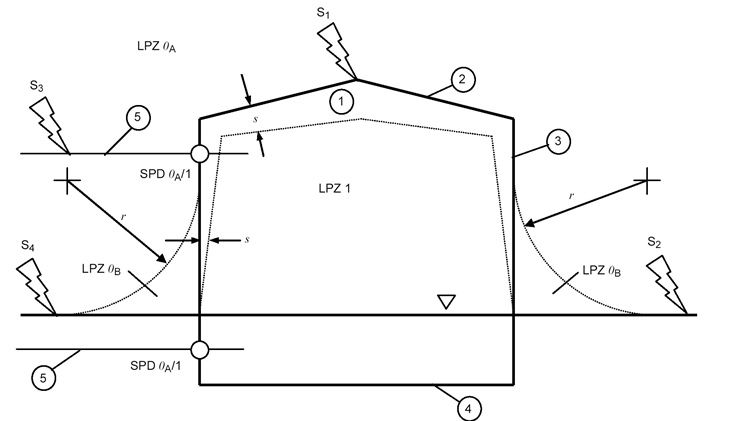(150. Lightning Protection System) presented in the revised KEC (Korean Electrical Equipment Code) is determined based on the KS C IEC 62305 standard. Therefore, this means that lightning protection system design that meets the KEC standard can be done by looking at the KS C IEC 62305 standard. Even if you look up KEC, it is the same as KS C IEC 62305.
Lightning protection zone (LPZ)
First, the lightning protection area for the lightning protection level is defined. The lightning protection area is as follows:
LPZ 0A direct lightning, total lightning current
LPZ 0B It is not a direct lightning strike, but a partial lightning current or induced current.
LPZ 1 Not a direct lightning strike, but limited lightning current or induced current.
It is divided into three parts (in the case of LPZ defined by LPS): 1 is the structure, 2 is the air-termination system, 3 is the down-conductor system, 4 is the grounding system, and 5 is the inlet facility. In the case of LPZ 0A, it is literally a direct lightning strike. And LPS 0B defines a lightning protection area where direct lightning cannot reach. In other words, if you are in the section inside LPZ 0B, lightning is induced to nearby LPZ 0A. In that case, you may think that it would be a good idea to properly create LPZ 0B to avoid direct lightning, and this can be configured appropriately using the air-termination system. The method used in this case is the rotating sphere radius.
External lightning protection system (E-LPS)
According to KS C IEC 62305-3, the external lightning protection system is constructed for the purpose of capturing direct lightning, including side lightning striking the structure, and flowing the lightning current from the lightning strike point to the ground. The external lightning protection system does not cause thermal or mechanical damage and discharges spark discharges that cause fire or explosion to the ground. In general, external lightning protection systems are installed on the structure to be protected, and if the air-termination system is designed properly, the probability of lightning current penetrating the structure is relatively reduced. This air-termination system consists of protruding needles, horizontal conductors, mesh conductors, etc. These air-termination systems can be arranged using the protective angle method, rotating sphere method, mesh method, etc. The rotating sphere method is commonly used.
The protective angle method can be applied within the range where H is less than the rotating sphere radius R. Literally, the concept is that the air-termination system protects all facilities within a certain protection angle. A lightning rod is erected in the center of the building, and this lightning rod protects the entire building like an umbrella. I think the picture below will be easier to understand.
Of course, a lightning rod and a horizontal conductor can be combined to form a tent-shaped protection radius.
Rotating sphere method (theoretical basis)
The rotating sphere method rolls a rotating sphere with a lightning strike radius R in all directions on the ground and determines the area inside the space that does not touch any point as the protection area. In other words, an air-termination system can be placed at each point where the rotating sphere touches the building. See picture below.






